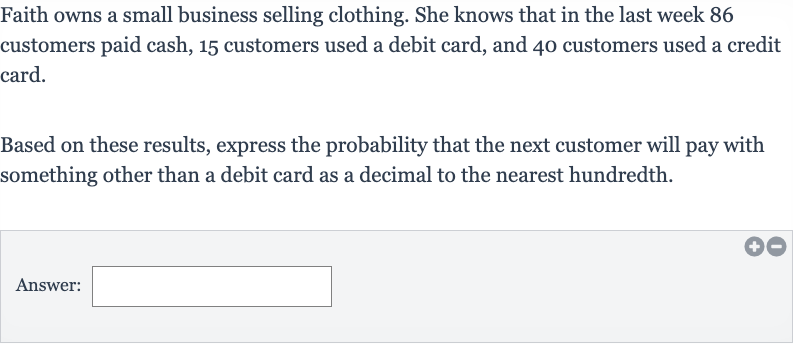AI tutor
Welcome to Bytelearn!
Let’s check out your problem:

Faith owns a small business selling clothing. She knows that in the last week customers paid cash, customers used a debit card, and customers used a credit card.Based on these results, express the probability that the next customer will pay with something other than a debit card as a decimal to the nearest hundredth.Answer:
Full solution
Q. Faith owns a small business selling clothing. She knows that in the last week customers paid cash, customers used a debit card, and customers used a credit card.Based on these results, express the probability that the next customer will pay with something other than a debit card as a decimal to the nearest hundredth.Answer:
- Calculate Total Customers: Determine the total number of customers from last week.To find the total number of customers, we add the number of customers who paid with cash, debit card, and credit card.Total customers Total customers
- Find Number Without Debit Card: Calculate the total number of customers.Now we perform the addition from Step to find the total number of customers.Total customers =
- Calculate Probability: Determine the number of customers who did not use a debit card.To find the number of customers who did not use a debit card, we add the number of customers who paid with cash and those who used a credit card.Customers not using a debit card Customers not using a debit card
- Convert to Decimal: Calculate the number of customers who did not use a debit card.Now we perform the addition from Step to find the number of customers who did not use a debit card.Customers not using a debit card
- Round to Nearest Hundredth: Calculate the probability that the next customer will pay with something other than a debit card.The probability is the number of customers who did not use a debit card divided by the total number of customers.Probability = Probability =
- Round to Nearest Hundredth: Calculate the probability that the next customer will pay with something other than a debit card.The probability is the number of customers who did not use a debit card divided by the total number of customers.Probability = Probability = Convert the probability to a decimal.To convert the fraction to a decimal, we perform the division from Step .Probability (as a decimal) =
- Round to Nearest Hundredth: Calculate the probability that the next customer will pay with something other than a debit card.The probability is the number of customers who did not use a debit card divided by the total number of customers.Probability = Probability = Convert the probability to a decimal.To convert the fraction to a decimal, we perform the division from Step .Probability (as a decimal) = Round the decimal to the nearest hundredth.To round to the nearest hundredth, we look at the third decimal place. Since the third decimal place is , we do not round up.Rounded probability =
More problems from Find probabilities using the binomial distribution
QuestionGet tutor help
QuestionGet tutor help
QuestionGet tutor help
QuestionGet tutor help
QuestionGet tutor help
QuestionGet tutor help
QuestionGet tutor help
QuestionGet tutor help
QuestionGet tutor help
QuestionGet tutor help
